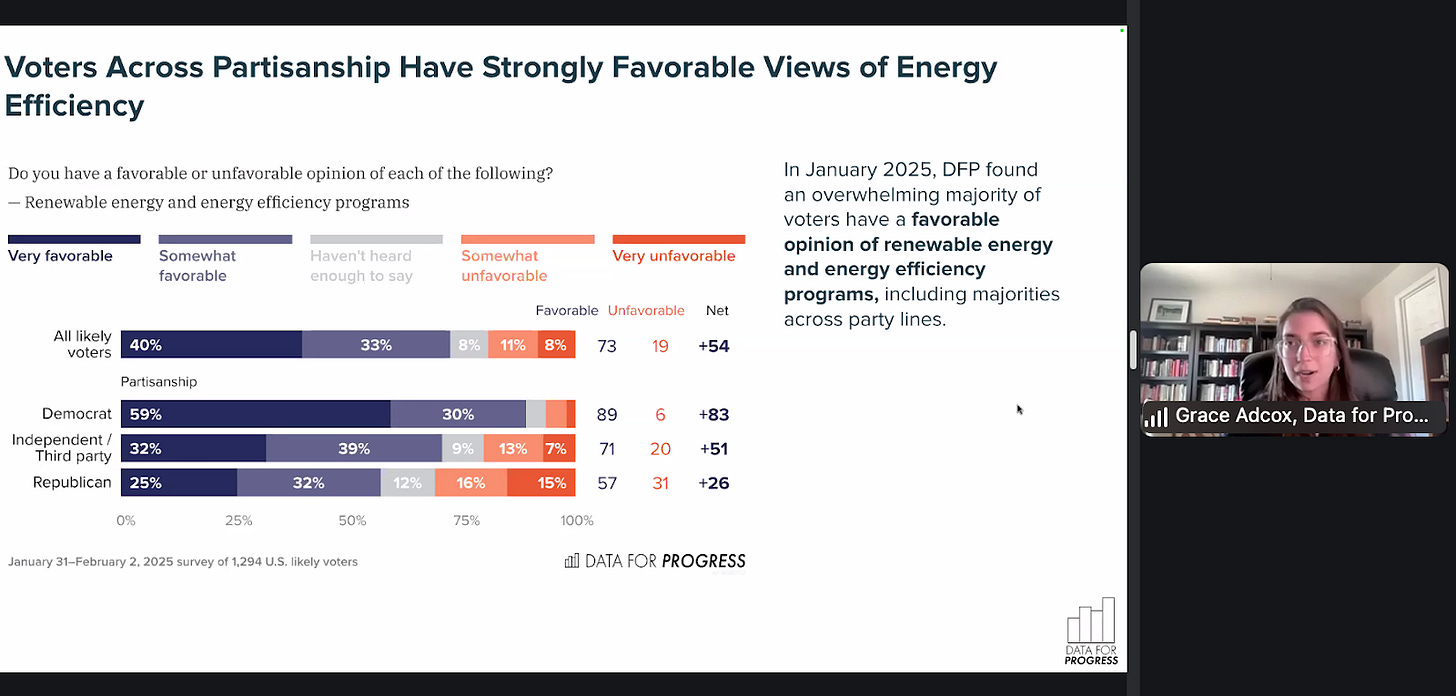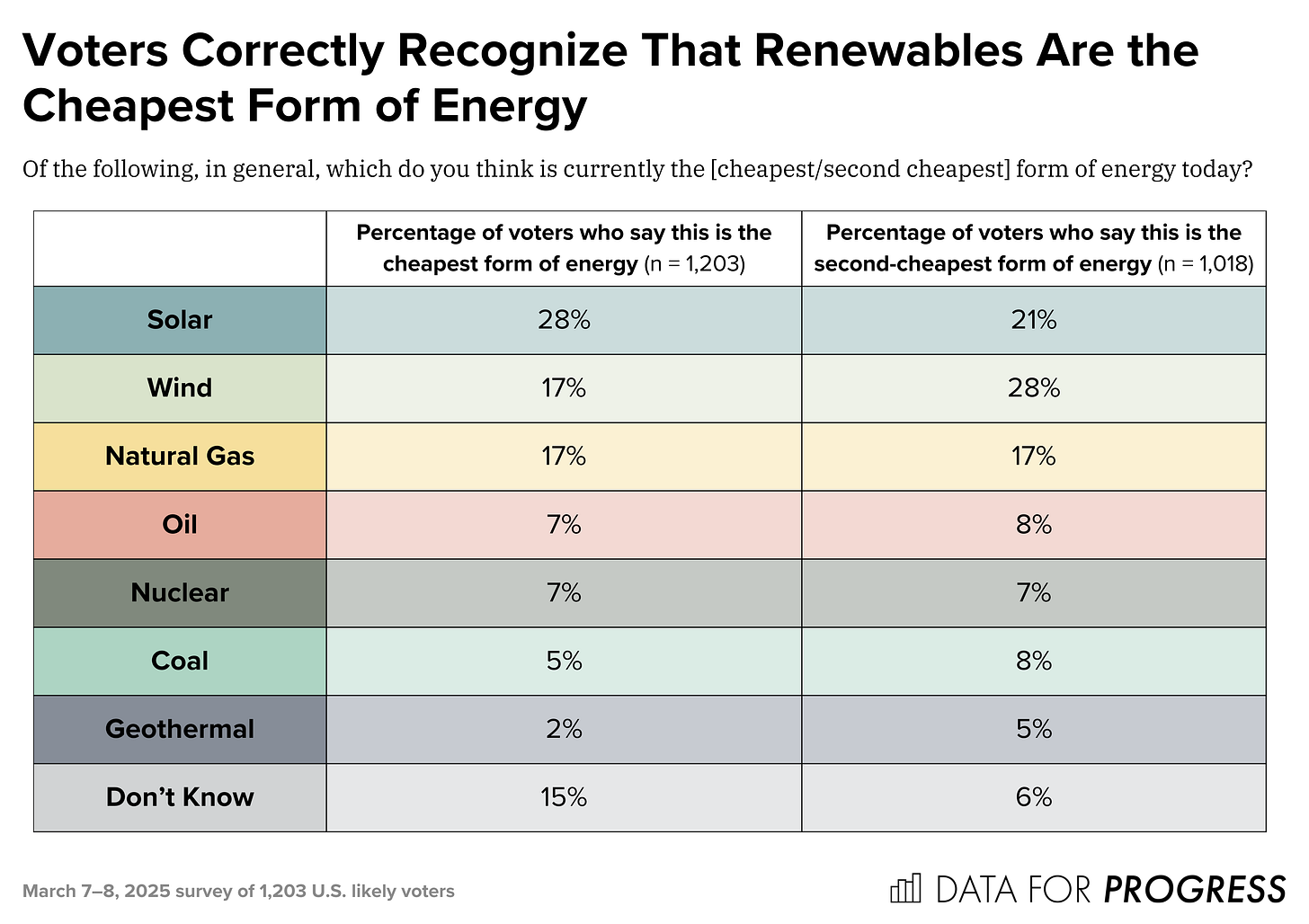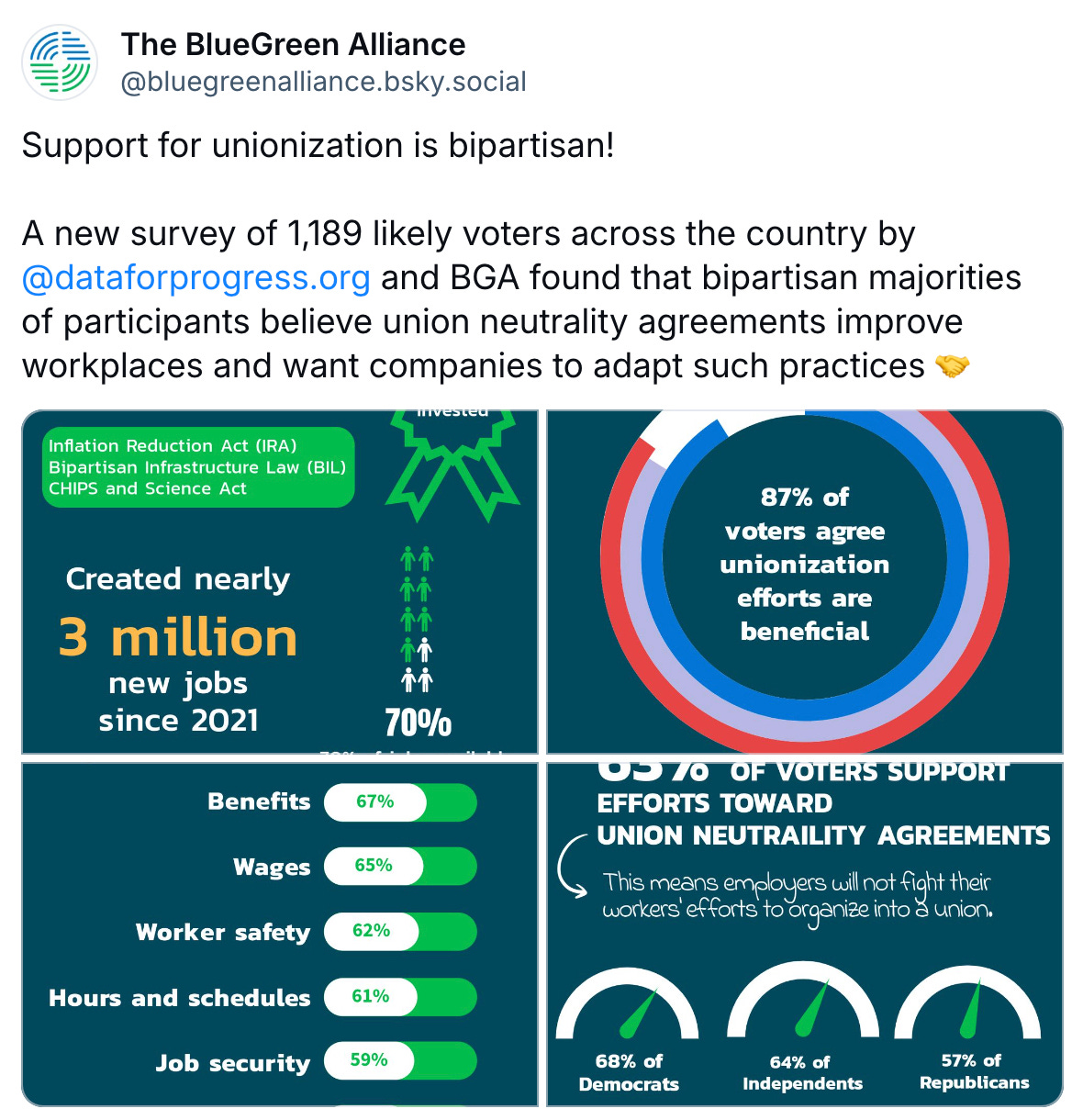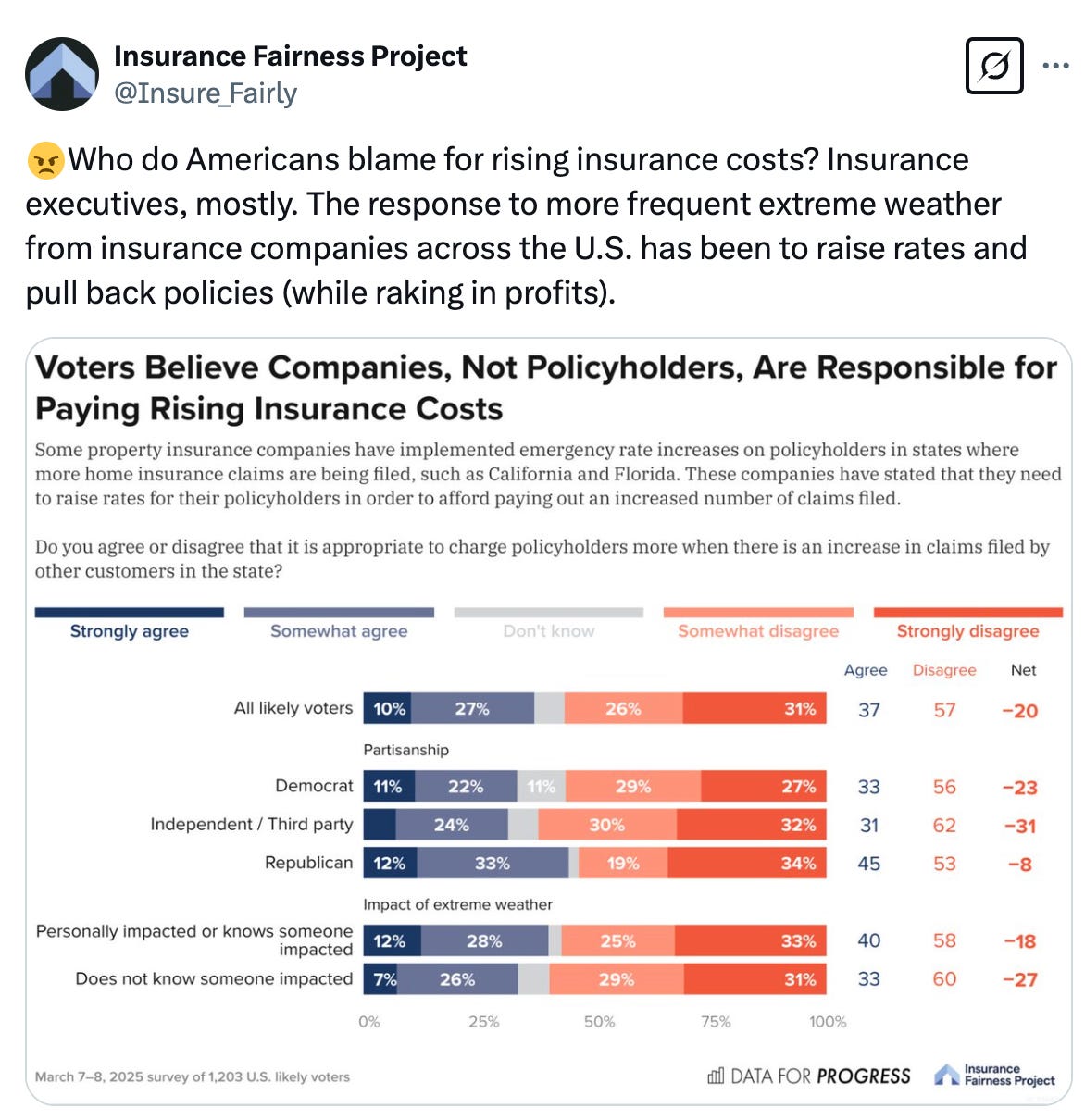“Energy Dominance” Doesn’t Pass the Sniff Test
Welcome back to Data for Climate Progress — your one-stop shop for all things climate at Data for Progress.
Welcome back to Data for Climate Progress — your one-stop shop for all things climate at Data for Progress. Catch us here every month for our latest climate polling, juicy insights, and can’t-miss reading lists.
As always, we’d love to hear from you — drop us (Grace Adcox and Catherine Fraser) a line at gracea@dataforprogress.org and catherine@dataforprogress.org. Forwarded this email? You can subscribe below.
Meet Data for Progress’ new senior resident fellow: Betony Jones!
This month, we’re thrilled to welcome Betony Jones (she/her) to DFP as our senior resident fellow for climate, labor, and economic policy. Though she likely needs no introduction to our readers, Betony has over 25 years of experience working across government, philanthropy, nonprofit and academic sectors to advance innovations at the intersection of climate change, labor, and economic development.
Most recently, as a senior advisor on labor to Secretary Granholm and director of the Office of Energy Jobs at the U.S. Department of Energy, she co-designed and led the department’s novel community benefits plan framework, which integrated strong labor and community standards across $500B of federally funded clean energy projects.
As a Senior Resident Fellow at Data for Progress, Betony focuses on making the guidance and data on good jobs and community benefits generated during the Biden administration accessible and actionable for organizers, advocates, and scholars to continue to demonstrate that the transition to a low carbon economy can lead to broadly shared prosperity.
Working at the intersection of climate and economic justice? Have an idea for a future survey? Just want to say hi? Feel free to reach out to Betony at betony@dataforprogress.org.
It’s Already Way Too Hard to Form a Union …
And companies can and should make it easier. In a new survey, BlueGreen Alliance and Data for Progress assessed attitudes toward unionization and federal investment, finding that voters view unionization efforts to be widely beneficial and think companies should remain neutral if their workers decide to organize a union. Voters know unions help workers. When asked if they think that workers unionizing would help, hurt, or have no effect on different issues in the workplace, a majority of voters think that unionizing would help improve benefits like insurance and time off (67%), wages (65%), worker safety (62%), and more. And they’re right — research shows that union workers earn 10% to 20% more than their nonunion counterparts. Union workers also have better job protections and benefits, like health care. Read BGA’s Ben Davis’ write-up here and our full brief here.
Government Is Good, Actually — Voters Want Government to Address the Home Insurance Crisis
Building on past national research, DFP and the Insurance Fairness Project surveyed likely voters to understand awareness and views of the national insurance crisis, and how voters want to resolve the industry’s compounding challenges, from rising insurance rates to providers increasingly refusing to renew policies. The TL;DR? More than three-quarters (78%) of voters are concerned about future increases in the price of property insurance. Who’s to blame for higher prices and insurers exiting the market? Voters place the most blame on insurance executives, with 85% of respondents saying they are at least somewhat responsible, though voters also think climate change-driven extreme weather and general economic inflation have played a role. And voters want to see their government step in to keep insurance prices fair and hold these companies to account. In fact, 61% of voters feel that the federal government is doing too little to ensure that home insurance companies are acting in their customers’ interests. Full findings here.
Watt’s the Verdict? Public Opinion on Energy Efficiency in the U.S.
The energy sector’s focus has been on rising energy demand and the need to build new electricity generation, but what about complementary energy efficiency initiatives? Data for Progress recently surveyed likely voters to gauge public perceptions and support for energy efficiency. We find that a bipartisan majority of voters support energy efficiency initiatives and financial incentives to bring down the upfront cost of making these upgrades. Voters are aware of the financial benefits of energy efficiency upgrades, including reduced electricity bills and increased property value, and on average think they would save 16.4% on their energy bills by installing energy-efficient appliances. Read the full brief here.
DFP at the Environmental Polling Consortium Quarterly Briefing
DFP’s Grace Adcox and Eva Brungard presented new energy efficiency polling to the EPC this month on voter awareness and perceptions of household energy efficiency improvements. We find that a bipartisan majority of voters (81%) view energy efficiency as an important climate solution; however, beyond switching to LED light bulbs, few voters have made energy efficiency improvements to their home. Voters state that the high upfront cost is their primary barrier, combined with a low awareness of available financial incentives.
Clean Energy Advocates Can Call Trump’s Bluff on His Pledge to “Unleash American Energy Dominance”
By Danielle Deiseroth
On his first day in office, President Donald Trump issued an executive order stating it is “in the national interest to unleash America’s affordable and reliable energy and natural resources.” Yet, in a paradoxical decision made later that same day, the Trump administration issued another order dealing a devastating blow to America’s wind energy industry by instituting withdrawals and roadblocks to onshore and offshore permits.
Keen observers of the energy industry immediately recognized the contradiction between Trump claiming to usher in a new era of American energy dominance while simultaneously blocking one of the nation’s fastest-growing and cheapest sources of energy.
But, taking a big step back: We know that voters strongly favor the U.S. investing more in renewable energy, but do they also know that renewable energy is cheap energy?
New research from Data for Progress confirms that a plurality of voters correctly recognize that renewables are the cheapest form of energy. When asked to identify what they think is the cheapest form of energy, 45% of voters say either solar or wind. When we followed up with these voters and asked them what they think the second cheapest form of energy is, again, nearly half say either solar or wind:
For clean energy advocates, who have spent years championing the economic benefits of the Inflation Reduction Act (IRA) as clean energy projects slowly come online, these executive orders provide a key opening to convince voters that Trump’s actions are in direct opposition to lowering costs for American families — which voters said was their top issue throughout the 2024 election cycle.
And it’s not just energy costs: The Trump administration’s hostility toward the clean energy industry and its overtures to kill key provisions of the IRA have stalled or cancelled the creation of nearly 50,000 jobs, according to new research from Climate Power.
As the future of the IRA and the U.S. renewable energy industry hangs in the balance, clean energy advocates can and should capitalize on the opportunity to craft an economic message that can actually land with voters: Invest in cheap and plentiful domestic clean energy sources that can lower utility costs for Americans while reducing our dependence on fossil fuels.
You can read this piece on our website here.
“The ‘critical minerals’ rush could result in a resource war,” by Thea Riofrancos (Financial Times)
“The IRA has a math problem,” by Emily Pontecorvo and Jael Holzman (Heatmap News)
“Even under Trump, Americans can fight climate change,” Sandeep Vaheesan (The American Prospect)
“Carbon removal facility seeks to marry wind power, innovation,” by Corbin Hiar (E&E News)


















